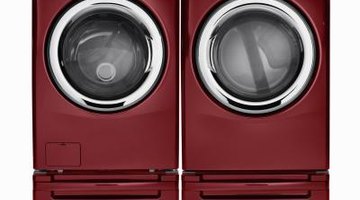Water Pressure From Washing Machine
Having enough water pressure in your home is important for the performance of equipment like sprinkler systems and washing machines. Water pressure dictates how fast a washing machine basin will fill, and low water pressure can affect the performance in newer machines. Understanding more about water pressure and its affects on washing machines will help you diagnose problems that might arise due to low water pressure.
About Water Pressue

Water pressure refers to the amount of force with which water exits a pipe. This force is typically measured in psi, or pounds per square inch. In a typical home, the water pressure should be set between 60 psi and 80 psi, although the number can vary depending on your needs. Washing machines are generally hooked up to the main water line using a fitting specially designed for the appliances to take full advantage of the maximum water pressure in your home.
Top-Loading Washing Machines and Water Pressue
Top-loading washing machines are generally mechanical. They use the amount of water in the basin to trigger a mechanical switch that shuts off the water and begins the wash cycle when the water reaches the full point. This design makes most top-loading washing machines excellent choices for home with low water pressure, because although it might take longer to fill the basin, the machine won't start the wash cycle until the basin is full.
Front-Loading Washing Machines and Water Pressure
Modern front-loading washing machines are a bit different than their mechanical top-loading counterparts. Front-loading machines use software programs to control the fill and wash cycles. If your machine has a low water pressure hookup, the program may detect a problem and abort the cycle. All models are different and may or may not be affected by low water pressure, but if your machine is aborting the wash cycle, chances are that low water pressure is to blame.
Improving Water Pressure to All Washing Machines
It's important to make sure that the hookups on your washing machine are clear of kinks or obstructions. Check behind the washer to make sure that the hose is draped from the machine to the water line without any sharp curves or kinks in the line. You also can adjust the amount of water pressure available to your entire home, including the washing machine, by adjusting the water pressure regulator along your main water line. Loosen the nut around the base of the regulator, and turn the adjustment screw on top to increase or decrease the total amount of water pressure available to all the appliances in your home.
References
Writer Bio
Heath Robert has been a professional writer since 2001. Covering news, politics and local communities, he has worked for daily newspapers across Colorado, including the "Columbine Courier" and the "Colorado Statesman." Robert holds Bachelor of Arts degrees in journalism and political science.
Photo Credits
- Ryan McVay/Photodisc/Getty Images
More Articles
- The Average Hot Wash Temperature in a Commercial Clothes Washer
- How Do Massaging Shower Heads Work?
- How to Locate an Underground Water Pressure Regulator
- How to Fix My Admiral Washing Machine That Will Not Agitate or Spin
- How Pressure Gauges on Well Pumps Work
- What is the Determination of Residual Water Pressure?



